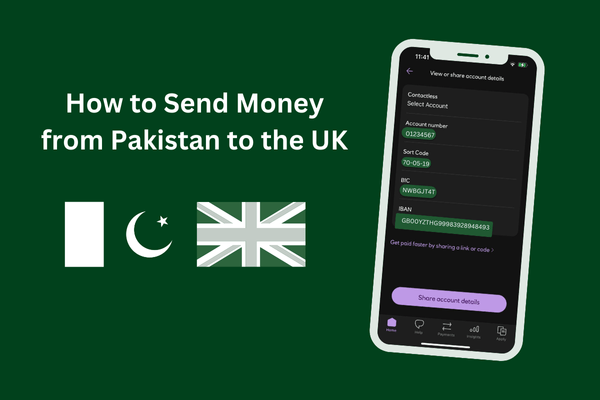
How to Send Money from the UK to Pakistan

Sending money from the UK to Pakistan can be straightforward, but with so many options available, it’s important to choose the right method. Whether you’re supporting loved ones, investing, or making business payments, understanding the best ways to transfer funds is key.
This guide covers various methods, key considerations, and tips to ensure a smooth and cost-effective transfer.
Reasons for Sending Money to Pakistan
People send money to Pakistan for numerous reasons, including:
- Supporting Family and Friends: Many individuals remit money to help with household expenses, education, and healthcare.
- Business Payments: Entrepreneurs and businesses often transfer funds to pay for services, partnerships, or suppliers.
- Property Investments: Some send money to invest in real estate or other financial opportunities.
- Special Occasions: Remittances for weddings, festivals, or other celebrations are also common.
Popular Methods to Send Money
There are several ways to transfer money from the UK to Pakistan, each with its own advantages and drawbacks. Here’s a look at the most popular options:
1. Bank Transfers
One of the most traditional and secure methods. UK banks offer international transfer services to Pakistani banks.
- Advantages: Reliable for large sums, secure, and can be done directly from your bank account.
- Drawbacks: Can be slow, with high fees and less favourable exchange rates.
2. Online Money Transfer Services
Services like Cambridge Currencies, Remitly, and XE provide online platforms for money transfers.
- Advantages: Competitive rates, lower fees, and faster processing times (sometimes within hours).
- Drawbacks: Requires internet access and can have limits on transfer amounts.
3. Money Transfer Operators (MTOs)
Companies like Western Union and MoneyGram have a strong presence in Pakistan, offering both cash pickup and bank deposits.
- Advantages: Quick transfers, cash pickup options, extensive network in Pakistan.
- Drawbacks: Higher fees, especially for cash pickups, and sometimes less favorable rates.
4. Mobile Wallets and Digital Payments
Mobile wallet services like Easypaisa and JazzCash are gaining popularity in Pakistan.
- Advantages: Convenient for recipients, especially in rural areas; instant transfers.
- Drawbacks: Requires both sender and receiver to have accounts; potential limits on transfer amounts.
5. Courier Services
For those who prefer a more physical method, sending a money order or bank draft via courier is an option.
- Advantages: Useful when electronic transfers aren’t feasible.
- Drawbacks: Slow and potentially risky if lost or delayed in transit.

Key Factors to Consider
1. Exchange Rates
Exchange rates can vary significantly between providers. Even a small difference can affect the amount your recipient receives. Always compare rates before sending.
2. Fees
Look out for both upfront fees and hidden charges. Some services might offer zero upfront fees but provide a poor exchange rate, costing you more in the end.
3. Transfer Speed
Depending on your urgency, the speed of the transfer can be crucial. While some services offer near-instant transfers, others may take several days.
4. Security and Trustworthiness
Ensure the provider you choose is reputable and regulated by financial authorities. This helps protect against fraud and ensures your money reaches its destination.
5. Customer Service
Access to good customer service is essential, especially if issues arise. Choose providers with strong support options, such as 24/7 helplines or online chat.
Steps to Send Money to Pakistan
- Select a Service: Based on your needs, choose a transfer service that offers the best combination of fees, rates, and speed.
- Create an Account: If using an online service or mobile wallet, sign up and verify your identity.
- Provide Transfer Details: Enter the amount, recipient’s details (name, bank account, or mobile wallet number), and select the delivery method.
- Make Payment: Pay using your preferred method, such as bank transfer, debit/credit card, or cash.
- Confirm and Send: Review the details and confirm the transfer. You’ll usually receive a confirmation and tracking number.
Tips for a Successful Money Transfer
- Shop Around: Use comparison websites to find the best rates and lowest fees like (RemitFinder)
- Consider Timing: Exchange rates fluctuate; sending money at a favorable rate can make a big difference.
- Avoid Last-Minute Transfers: Planning ahead can help you avoid higher fees for expedited transfers.
- Check for Promotions: Some services offer discounts or promotional rates, especially for first-time users.
- Verify Details: Always double-check the recipient’s information to avoid delays or issues.
Frequently Asked Questions
Q: How long does it typically take to send money from the UK to Pakistan? A: It varies by method. Bank transfers can take 1-5 business days, while online services and MTOs can be instant or within a few hours.
Q: What do I need to send money to Pakistan? A: You’ll generally need the recipient’s name, bank account details or mobile wallet number, and a valid ID for verification.
Q: Are there any transfer limits? A: Yes, limits vary by service provider and payment method. Check with your chosen provider for specific limits.
Q: Can I send money to a mobile wallet in Pakistan? A: Yes, services like Easypaisa and JazzCash allow transfers directly to mobile wallets, which can then be used for various transactions or cash withdrawals.
Q: What should I do if there’s a problem with my transfer? A: Contact the customer service of your provider immediately with your transaction details and tracking number.
Conclusion
Sending money from the UK to Pakistan has never been easier, thanks to the variety of methods available. Whether you prefer traditional bank transfers or modern digital services, there’s an option to suit every need. By considering exchange rates, fees, and transfer speeds, you can make the most of your money and ensure it arrives safely.
Remember, a little research and planning can go a long way in making your money transfer experience seamless and cost-effective. Happy sending!